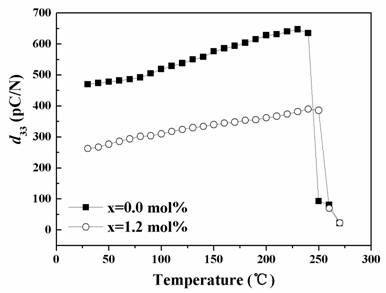High temperature piezoelectric ceramics are key materials for piezoelectric actuators and sensors working under harsh environments (>300 °C), especially in the aerospace and automotive industries. The BiScO3-PbTiO3 (BSPT) system with a composition near the Morphotropic Phase Boundary (MPB) shows excellent piezoelectric properties with still a high Curie temperature (Tc) of about 450 °C. However, a problem is its high dielectric loss and a low mechanical quality factor (Qm ≈ 15–50), which leads to a relatively high degree of energy dissipation.
Doping with metal elements or addition of a new component to form a complex ternary or quaternary system are two typical ways that can substantially modify the performance of the piezoelectric ceramics. However, for most of the doped BSPT and BSPT-based complex systems, the reported dielectric loss values are very high, and the available Qm data are rather scattered. In the BSPT-based complex systems, the effects of doping are very complicated, because most of the systems (e.g. PMN, PMnN and PZN) introduced are relaxor type materials. Therefore, analysis of the property alteration in the doped BSPT based complex system is of both practical and theoretical significance.
In this research, to get a better understanding of the effect of doping on the BSPT type complex ceramics and to improve the material performance, Fe is selected as a model dopant. And its effects on the electrical properties and microstructure of BSPT-PZN complex system with a composition 0.35BiScO3-0.6PbTiO3-0.05Pb(Zn1/3Nb2/3)O3near the MPB boundary were systematically studied. The dielectric loss and the mechanical quality factor of the samples were, respectively, reduced and increased for about three times by doping.
The turning point in most of the electrical parameters implies that the doping characteristics are mainly caused by the increased tetragonality (x < 0.4 mol%) or by the substitution induced defects (x > 0.4 mol%). Despite the complicated influence of Fe on the complex high temperature piezoelectric ceramics, it may still be used to significantly improve the “hardness” of similar materials required for high power applications. More importantly, for the first time, direct measurement of the high temperature d33 by using the Berlincourt method was performed in this study (Fig. 1). The results indicated a depolarization temperature (250–260 °C) much lower than the peak value temperature (Tm~410–440 °C) in the temperature dependence of dielectric constant.

Fig. 1.The high temperature d33 of BSPT-PZN and BSPT-PZN-Fe2O3 ceramic sample directly measured by the Berlincourt method (Image by GUO).
This research was supported by the National Key Basic Research Program of China (973 Program, Grant No. 2013CB632900), and the National Science Foundation of China (NSFC No. 11074277). Help of the Open Foundation of the State Key Laboratory of New Ceramics and Fine Processing of Tsinghua University was also appreciated.
The research entitled “Effect of Fe Doping on the Structure and Electric Properties of Relaxor Type BSPT-PZN Piezoelectric Ceramics near the Morphotropic Phase Boundary” has been released in the Sensors and Actuators A: Physical (Volume 201, 15 October 2013, Pages 222–229) with the url of http://www.sciencedirect.com/science/article/pii/S092442471300349X.
Corresponding author:
GUO Dong
Institute of Acoustics, Chinese Academy of Sciences, Beijing, 100190, China
Email: dong.guo@mail.ioa.ac.cn


